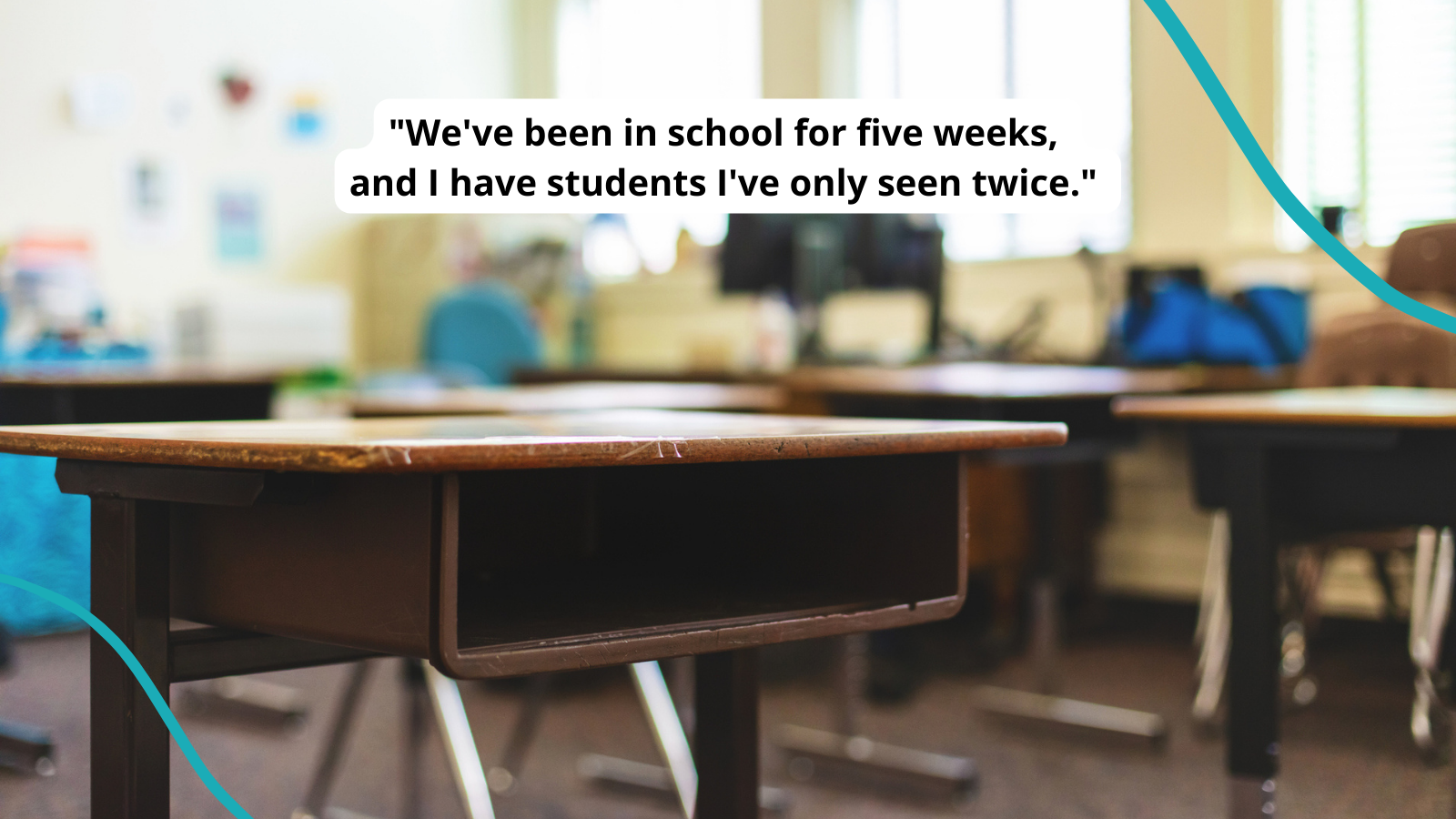We all saw the slow creep of chronic absenteeism during the pandemic. Between students’ physical illnesses, changes in mental health, and distance, absenteeism was hard to address during virtual learning.
But unfortunately, this problem has only gotten worse since we’ve been back in school. Recent data from a White House Council of Economic Advisers (CEA) report reveals that around 30% of students in the United States were chronically absent in 2021, highlighting the urgent need for a comprehensive and collaborative effort to address this issue.
What is chronic absenteeism?
Teachers know students need to be absent from time to time. Chronic absenteeism is a persistent pattern of missing school, defined by the CEA study as “missing 10 percent or more of the school year, or about 18 days of school for a typical 180-day academic year.”
Regularly missing school can have serious consequences for students and their communities, affecting not only short-term academic outcomes but also their futures.
The impact of COVID-19
The COVID-19 pandemic wreaked havoc on the education system, disrupting the traditional modes of learning.
First, it made everyone question the usefulness of a seven- or eight-hour school day. Elmer Roldan, who runs a dropout prevention group, pointed out to the Los Angeles Times how COVID exacerbated the issue of chronic absenteeism. “For almost two years, we told families that school can look different and that schoolwork could be accomplished in times outside of the traditional 8-to-3 day,” Roldan said. “Families got used to that.”
Second, it made parents more receptive and tuned in to children’s mental health. While this shift in focus clearly has its benefits, it has a flip side too. According to Lisa Damour, author of The Emotional Lives of Teenagers, allowing anxious or stressed students to miss school has a cost. Damour told the New York Times, “When any of us are fearful, our instinct is to avoid. But the problem with giving in to that anxiety is that avoidance is highly reinforcing.”
How does being absent hurt kids?
The implications of chronic absenteeism reach far beyond a single school year. As any teacher knows, frequent absences affect skill development and retention.
What teachers might not know is that students who can’t read on grade level in third grade are four times more likely than their peers to drop out of high school. Even a single year of frequent absences between 8th and 12th grades means a student is seven times more likely to drop out. And dropping out is linked to all kinds of negative outcomes, from poverty to diminished health to crime.
What’s more is that according to ed.gov, chronic absenteeism disproportionately affects students from under-resourced areas, amplifying existing achievement gaps.
The CEA’s analysis emphasizes the need for urgent action, pointing out that absenteeism has not returned to pre-pandemic levels even as schools have reopened.
What teachers are saying about chronic absenteeism
What teachers are saying boils down to a few key points:
1. The problem is real.
Teachers confirm that the problem is very real and widespread. Here’s what one Reddit teacher has to say about this school year so far:
“I’ve been a high school teacher for 12 years, and before COVID, I only had a handful of students in my entire career who missed school regularly. Since COVID hit, it’s been rampant. We’ve only been in session for 20 school days this year and I already have several students who have missed 8-10 of those days.”
Another teacher says, “We’ve been in school for 5 weeks as a 4-day-week district and there are students I’ve maybe seen twice. Some I’ve never seen at all.”
2. Some schools lack policies aggressive enough to change attendance.
This teacher asks, “How are we as a staff supposed to help improve student attendance and reduce chronic absenteeism when our district does not have any policies in place to enforce real consequences?”
One teacher brought up a case of chronic absences in which the district’s response set a surprising precedent:
“We’re dealing with a situation where a parent filed a complaint with the board when her daughter missed 34 days. The mom was a teacher in a different district and stated that it is illegal to fail a student due to absences as long as they pass their classes, which her daughter did. Now we walk a fine line of ‘Don’t miss too much school or else’ and hoping kids don’t realize what they can get away with.”
3. Other schools’ policies have been too aggressive.
In the case of schools coming down too hard on attendance policies, parents are left understandably frustrated. But some schools are requiring doctor’s notes for any absence due to illness, leaving parents asking, “Have you tried to get a same-day doctor’s appointment in 2023?”
How do we fix this?
Alleviating the problem of chronic absenteeism comes down to the same things we need to fix our other education problems: funding.
Schools facing chronic absenteeism need funding for:
- Personnel to keep and analyze data on student attendance patterns
- Additional staffing to identify chronically absent students and provide targeted intervention earlier
- Smaller class sizes and more individualized attention and connection
- More community liaison roles
- Mental health counselors and mental health resources
- Flexible learning options for severe cases
Though it’s true that we need a holistic, all-hands-on-deck approach to improve chronic absenteeism, we can do very little if the hands with the money remain tightfisted.

